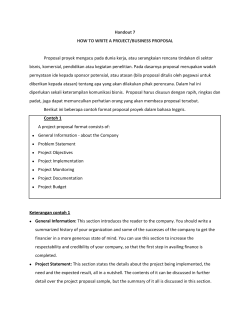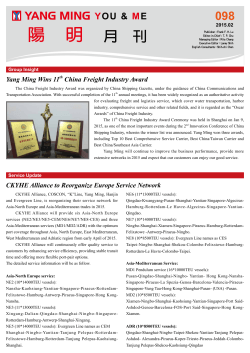
Organizational Culture Chapter 13 IBUS 681, Dr. Yang 1
Organizational Culture Chapter 13 IBUS 681, Dr. Yang 1 Learning Objectives Define organizational culture and know why it is important Distinguish among organizational, national, and global culture and understand the relationships among them Evaluate the culture-free approach to understanding organizational culture IBUS 681, Dr. Yang 2 Learning Objectives (cont.) Identify levels of organizational culture Know what organizational culture does Discuss the cultural dimensions and typology approaches to understanding organizational culture Understand how organizational culture can be managed IBUS 681, Dr. Yang 3 Organizational Culture A pattern of basic assumptions - invented, discovered, or developed by a given group as it learns to cope with its problems of external adaptation and internal integration That has worked well enough to be considered valid and, therefore, to be taught to new members as the correct way to perceive, think, and feel in relation to those problems (Schien, 1985). IBUS 681, Dr. Yang 4 National and Global Culture Relationship between national and corporate culture is complex: “Logic of industrialization" may affect all organizations the same way National culture and other elements in an organization's environment may determine internal organizational culture Globalization also affects organizational culture IBUS 681, Dr. Yang 5 Henry Ford, founder of the Ford Motor Company said: Getting together is beginning Keeping together is progress Working together is success IBUS 681, Dr. Yang 6 National and Global Culture One can not understand what’s going on inside an organizational culture without understanding what exists outside the boundary. National culture provides basic assumptions that legitimize and guide organizational behavior. Industrialization promotes changes in national culture. Globalization increases awareness of successful practices elsewhere. Modern communication enhances connections among manufacturers, merchants, financiers, consumers, etc. globally. MNCs seek consistency and shape organizational culture on a global basis. IBUS 681, Dr. Yang 7 Culture-Free Approach It argues that technology, policies, rules, organizational structure, and other variables that contribute to efficiency and effectiveness make national culture irrelevant for management. McDonald’s fast food service World Disney IKEA Disney Paris Ears IBUS 681, Dr. Yang 8 Understanding Organizational Culture Organizations are culture free in some respects, but culture bound in many others (Trice & Beyer, 1993). Global, national, and organizational elements interact to influence organizational culture and behavior. IBUS 681, Dr. Yang 9 McDonald's Restaurants Moscow or some others Types of the restaurant Food adaptation Service adaptation Perceptions of jobs Workplace culture Employee commitment IBUS 681, Dr. Yang U.S. Fast food life style Convenience Temporary jobs High turnover rate Standard food items 10 Levels of Organizational Culture Artifacts Espoused Values Actual Values Basic Underlying Assumptions Subcultures IBUS 681, Dr. Yang 11 Artifacts IBUS 681, Dr. Yang 12 Microsoft’s Mission: To enable people and businesses throughout the world to realize their full potentials IBUS 681, Dr. Yang 13 Great People with Great Values Delivering on our mission requires great people who are bright, creative, and energetic, and who share the following values: Integrity and honesty. Passion for customers, partners, and technology. Open and respectful with others and dedicated to making them better. Willingness to take on big challenges and see them through. Self-critical, questioning, and committed to personal excellence and self-improvement. Accountable for commitments, results, and quality to customers, shareholders, partners, and employees. IBUS 681, Dr. Yang 14 National Vs. Organizational Culture National culture Organizational culture Broader More complex Influence org. culture Primary and secondary socialization IBUS 681, Dr. Yang Narrower Manageable Secondary socialization Subcultures 15 What Organizational Culture Does FUNCTIONS Provides an external identity Creates a sense of commitment Acts as source of high reliability Defines an interpretive scheme Acts as a social control mechanism DYSFUNCTIONS Can create barriers to change Can create conflict within the organization Subcultures can change at different rates than other units IBUS 681, Dr. Yang 16 Some Underlying Dimensions of Organizational Culture Dimension Questions to be answered 1. The organization’s relationship to its environment Does the organization perceive itself to be dominant, submissive, harmonizing, searching out a niche? 2. The nature of human activity 3. The nature of reality and truth Is it the “correct” way for humans to behave to be dominant/proactive, harmonizing, or passive/fatalistic? How do we define what is true and what is not true; and how is truth ultimately determined both in the physical and social world? IBUS 681, Dr. Yang 17 Some Underlying Dimensions of Organizational Culture (cont.) Dimension Questions to be answered 4. The nature of time What is our basic orientation in terms of past, present, and future, and what kinds of time units are most relevant for the conduct of daily affairs? 5. The nature of human nature Are humans basically good, neutral, or evil, and is human nature perfectible or fixed? IBUS 681, Dr. Yang 18 Some Underlying Dimensions of Organizational Culture (cont.) Dimension Questions to be answered 6. The nature of human What is the “correct” way for people to relate to each other, to distribute power and affection? Is relationships life competitive or cooperative? Is the best way to organize society on the basis of individualism or groupism? Is the best authority system autocratic/paternalistic or collegial/participative? 7. Homogeneity versus Is the group best off if it is highly diverse or if it is highly homogeneous, and should individuals in a diversity group be encouraged to innovate or conform? IBUS 681, Dr. Yang 19 Trompenaars’ Four Corporate Cultures Family Culture Eiffel Tower Culture Guided Missile Culture Incubator Culture IBUS 681, Dr. Yang 20 Characteristics of Trompenaars’ Four Types of Corporate Culture Variables Family Eiffel Tower Guided Missile Incubator Relationship between employees Diffuse relationships to organic whole to which one is bonded Specific role in mechanical system of required interactions Specific tasks in cybernetic system targeted upon shared objectives Diffuse, spontaneous relationships growing out of shared creative process Attitudes toward authority Status is ascribed to parent figures who are close and powerful Status is ascribed to superior roles, which are distant yet powerful Status is achieved by project group members who contribute to targeted goals Status is achieved by individuals exemplifying creativity and growth Ways of thinking and learning Intuitive, holistic, lateral, and errorcorrecting Logical, analytical, vertical, and rationally efficient Problems centered, professional, practical, cross-disciplinary Process oriented, creative, an hoc, inspirational Attitudes towards people Family members Human resources Specialists and experts Co-creators Ways of changing “Father” changes course Change rules and procedures Shift aim as target moves Improvise and attune Ways of motivating and rewarding Intrinsic satisfaction in being loved and respected Promote to greater position, larger role Pay or credit for performance and problems solved Participating in the process of creating new realities Management style Management by subjectives Management by job description Management by objectives Management by enthusiasm Criticism and conflict resolution Turn other cheeks, save others’ faces, do not lose power game Criticism is accusation of irrationalism unless there are procedures to arbitrate conflict Constructive taskrelated only, then admit error fast and correct Must improve creative idea, not negate it Managing and Changing Organizational Culture Leadership and organizational culture Elements of culture leaders can change Employee selection criteria Socialization of new members Meaning of work Artifacts/surface manifestations of culture IBUS 681, Dr. Yang 22 Convergence or Divergence? Industrialization Emphasis on standardization Organizational strategies for managing culture globally Emphasis on consistency across borders Use of organizational culture as a competitive tool Impact of diverse national cultures on organizational culture Benefits in specific and culturally sensitive ways MNCs Global institutions IBUS 681, Dr. Yang Seniority Job security Group versus individual 23 Implications for Managers For managerial effectiveness, it is helpful to analyze organizational cultures in order to coordinate activities or change them; Understand what levels of culture can be influenced and how; Know how national culture and organizational culture can interact to influence management philosophy and employee behaviors. Person-culture fit for individual career success IBUS 681, Dr. Yang 24
© Copyright 2025












